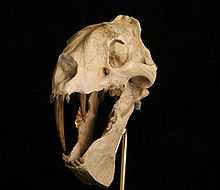Eusmilus
| Eusmilus Temporal range: Late Eocene - Late Oligocene | |
|---|---|
 | |
| Eusmilus | |
| Conservation status | |
| Fossil | |
| Scientific classification | |
| Kingdom: | Animalia |
| Phylum: | Chordata |
| Class: | Mammalia |
| Order: | Carnivora |
| Family: | Nimravidae |
| Genus: | Eusmilus Gervais, 1876 |
| Species | |
|
†Eusmilus bidentatus | |
Eusmilus ('true sabre') is a prehistoric genus of the family Nimravidae, subfamily Hoplophoninae endemic to North America, Europe,and Asia during the Late Eocene-Early Oligocene epochs (37.2—28.4 mya), existing for approximately 8.8 million years.[1]
Taxonomy
Ekgmoiteptecela was named by Macdonald (1963). Its type is Ekgmoiteptecela olsontau. It was synonymized subjectively with Eusmilus by Martin (1980), Bryant (1984) and Bryant (1996).[2][3][4]
Species
- Eusmilis bidentatus
- Eusmilis cerebralis
- Eusmilus olsontau
- Eusmilus sicarius
Morphology
Eusmilus had a long body and was about as tall as a leopard. It had developed long saber teeth and looked like a saber-toothed cat, but was actually a so-called 'false saber-tooth'. Most were leopard-sized and rather long-bodied and short-legged compared to modern leopards. Some reached 2.5 metres (8 ft) long. Eusmilus had lost many other teeth, possessing only 26 instead of the 44 usually seen in carnivore mammals. Its mouth could open to an angle of 90 degrees, allowing the creature to properly use its saber teeth. Bony flanges projected from Eusmilus ' lower jaw to protect the sabers (this is also seen in the unrelated marsupial Thylacosmilus and felid Megantereon). There is fossil evidence of conflict between Eusmilus and Nimravus, another genus of nimravid.[5]
A single specimen was examined by Legendre and Roth for body mass and was estimated to have a weight of 70 kg (150 lb).[6]
References
- ↑ PaleoBiology Database: Eusmilus, basic info
- ↑ J. R. Macdonald. 1963. The Miocene faunas from the Wounded Knee area of western South Dakota. Bulletin of the American Museum of Natural History
- ↑ L. D. Martin. 1980. Functional morphology and the evolution of cats. Transactions of the Nebraska Academy of Sciences 8:141-153
- ↑ H. N. Bryant. 1996.
- ↑ Dixon, Dougal; Cox, Barry; Savage, R.J.G.; Gardiner, Brian (1988). The Macmillan Illustrated Encyclopedia of Dinosaurs and Prehistoric Animals: A Visual Who's Who of Prehistoric Life. Macmillan Publishing Company. p. 224. ISBN 0-02-580191-0.
- ↑ S. Legendre and C. Roth. 1988. Correlation of carnassial tooth size and body weight in recent carnivores (Mammalia). Historical Biology.